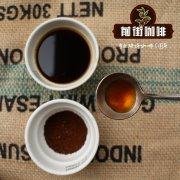Introduction to the flavor and taste of Ethiopian boutique coffee Yejia snow coffee song G1 sun-dried coffee producing area

Professional coffee knowledge exchange more coffee bean information please follow the coffee workshop (Wechat official account cafe_style)
With regard to Ethiopia, Ethiopia is the birthplace of coffee and the only place where indigenous people grow their own coffee. Coffee was first discovered by shepherds in the Essekafa region and its name evolved from Kaffa.
Geography
Yega Xuefei is similar to neighboring Sidamo in both cultural and geographical environment, but Yega Xuefei seems to be more favored to enjoy better conditions. with floral aroma, bright citrus acid, lemon flavor, silky taste, firmly grasp the eyes of enthusiasts, under the growth wave of the imported coffee industry. Coffee production in this area has always been the focus of buyers' attention.
Gaode town
This coffee bean comes from the town of Gode in southern Ethiopia, and most farmers grow it in their own backyard or mixed with other crops in their farms. the yield per household is small, and it is a typical pastoral coffee. These mountain villages are foggy, like spring all year round, and the summer breeze is slow. Cool but not hot, rain but not damp, winter is not cold damage, giving birth to a unique citrus and floral [regional flavor]. Yejia snow caffeine is washed with water, but some of the best beans are processed in the sun to enhance the charming fruit aroma and mellow thickness, such as Gideon G1.
Gade processing plant
Farmers ship ripe berries to a processing plant in Gould Town and then screen them immediately to remove defective beans and foreign objects. The treatment plant first put the screened red fruit directly on the drying bed. In the first few days to prevent excessive fermentation, it should be turned once in 2-3 hours. Because the sun-dried beans are also very sensitive to the surrounding environment, if there is more or damp rain in the daily drying treatment, it is easy to grow bacteria or mildew, so the risk is higher than that of washing.
Sun processing requires a drying process of 15-20 days on an African bed. In this process, the fruit will be turned frequently to avoid damage. When the moisture in the berries drops to 11.5-12%, the parchment is peeled and shipped to the local warehouse for storage. It was finally shipped to Addis Ababa to wait for the exit.
Generally after the sun treatment of Yejia Xuefei, the texture will be more mellow, resulting in a deeper flower and fruit flavor. Taste similar to lemon and citrus complex, excellent taste viscosity, pleasant aroma, endless flavor.
Area: Gedeh town processing plant in the south of Yejasuffe.
Grade: G1
Treatment: insolation
Variety: original species (Heirloom)
Altitude: 1850m~2000m
Harvest season: November-January
Cup test information: blackcurrant, raisin, apricot shop, grapefruit meat, sticky concentration
Recommended baking degree: City
END
Important Notice :
前街咖啡 FrontStreet Coffee has moved to new addredd:
FrontStreet Coffee Address: 315,Donghua East Road,GuangZhou
Tel:020 38364473
- Prev

Grade G1 of Sumatran honey treatment in the Burnamaria Highlands, Indonesia
Professional coffee knowledge exchange more coffee bean information please follow the coffee workshop (Wechat official account cafe_style) Manning: has a high mellow thickness, moderate acidity, strong cocoa nut flavor. Suitable for deep baking, emitting a strong fragrance. Wet planing mainly exists on the Indonesian island of Sumatra. Locally, coffee removes the peel and flesh, removes the gum, and retains the endocarp.
- Next

Costa del boutique coffee Galaclajas Manor Kaddura Kaduai Diamond Honey treatment
For more information on coffee beans, please follow the coffee workshop (Wechat official account cafe_style) Costa Rican Coffee is produced in the Republic of Costa Rica (The Republic of Costa Rica) in the south of Central America. Its quality is similar to Colombian coffee and is suitable for blending mixed coffee. In 1848, the Republic of Costa Rica was established. In 2007, with
Related
- Detailed explanation of Jadeite planting Land in Panamanian Jadeite Manor introduction to the grading system of Jadeite competitive bidding, Red bid, Green bid and Rose Summer
- Story of Coffee planting in Brenka region of Costa Rica Stonehenge Manor anaerobic heavy honey treatment of flavor mouth
- What's on the barrel of Blue Mountain Coffee beans?
- Can American coffee also pull flowers? How to use hot American style to pull out a good-looking pattern?
- Can you make a cold extract with coffee beans? What is the right proportion for cold-extracted coffee formula?
- Indonesian PWN Gold Mandrine Coffee Origin Features Flavor How to Chong? Mandolin coffee is American.
- A brief introduction to the flavor characteristics of Brazilian yellow bourbon coffee beans
- What is the effect of different water quality on the flavor of cold-extracted coffee? What kind of water is best for brewing coffee?
- Why do you think of Rose Summer whenever you mention Panamanian coffee?
- Introduction to the characteristics of authentic blue mountain coffee bean producing areas? What is the CIB Coffee Authority in Jamaica?

